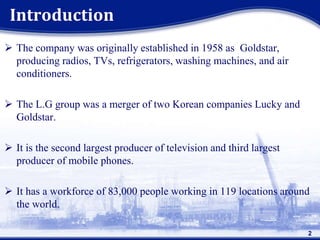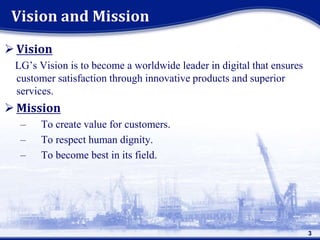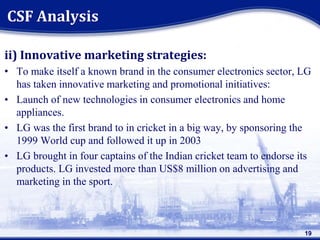Strategy analysis of lg
- 1. Strategic Analysis of Presented By: Sarthak Omer (PGSF1443) Shruti Jain (PGSF1445) Shubhanshi Rathore (PGSF1446) Shweta Singh (PGSF1447)1
- 2. Introduction ï The company was originally established in 1958 as Goldstar, producing radios, TVs, refrigerators, washing machines, and air conditioners. ï The L.G group was a merger of two Korean companies Lucky and Goldstar. ï It is the second largest producer of television and third largest producer of mobile phones. ï It has a workforce of 83,000 people working in 119 locations around the world. 2
- 3. ï Vision LGâs Vision is to become a worldwide leader in digital that ensures customer satisfaction through innovative products and superior services. ï Mission â To create value for customers. â To respect human dignity. â To become best in its field. Vision and Mission 3
- 6. 6
- 7. âĒ Political analysis: In LG electronics political analysis includes: High import duty, digitalization in India, government intends to promote local manufacturing, plants in tax incentive and export promotion schemes of the Indian Government. âĒ Economic analysis: In LG electronics economic analysis includes: increase in per capita income, growing GDP high disposable income and increase in spending, constant turbulence in the value of rupee, availability of easy finance option. PEST analysis 7
- 8. âĒ Social analysis: enhance purchasing power, population growth rate, age distribution, employment pattern. âĒ Technological analysis: LG electronics focuses on acquiring advanced technologies to drive forward. The improvement in technology they made the electronic products. LG electronics goal is to lead global electronics and information technology worldwide. It increasing its focus on âsmart technologyâ. PEST analysis 8
- 9. âĒ STRENGTH ï Wide range of products to serve all categories and a strong focus on technology and quality ï Effective localization of product offerings for growth markets ï Brand offers sound rational appeal â good product features and good value for money ï Good after sales service and wide distribution network ï Sponsorship of sports and entertainment events enhances visibility SWOT Analysis 9
- 10. âĒ WEAKNESS ï Brand lacks influence in the segment of early adopters especially in the social media environment ï Brand has limited market share compared to market leaders SWOT Analysis 10
- 11. âĒ OPPORTUNITY ï Fast growth of home appliances, electronics goods market in emerging economies ï Convert improved brand image and awareness in to market share ï Increase the already Wide product portfolio SWOT Analysis 11
- 12. âĒ THREATS ï Price war with close Korean competitors like Samsung can disrupt growth in price sensitive markets ïHighly competitive industry dynamics SWOT Analysis 12
- 13. Bargaining power of supplier (Low): âĒ low product differentiation âĒ switching cost is low âĒ supplier concentration to firm concentration is high Bargaining power of buyer (High): âĒ Bulk purchase âĒ Price sensitivity âĒ Likely backward integration Threats of substitute (High): âĒ Possibility of a technology substitute âĒ Relative price performance is high FIVE Force Model 13
- 14. Threat of competition (High): âĒ The enduring conflict with Sony and Samsung for the purpose of gaining customer share is too high. The competition is more intense as these firms pursue strategies that give competitive advantage over the strategies pursued by its rivals. Threats of new entry (Low): âĒ Potential entry of new competitors is an important factor to intensify competition in the industry. Larger the band of new entrants, more intense will be the competition. Considering the trait of product differentiation, âĒ Large capital requirement âĒ High economies of scale FIVE Force Model 14
- 15. Ansoff Matrix 15 Plasm a TV LED TV Smar t TV CRT TV LCD TV Home Theatre s MP3 Players & Speake rs Market Penetration Product Development Market Development Diversification New Markets Existing Markets Existing Products New Products Smart TV LED TV
- 16. BCG Matrix- LG Electronics STAR LGâs Television QUESTION MARK LGâs Computers CASH COW LGâs White Goods DOGS LGâs Mobiles BCG Matrix
- 17. Competitors 17
- 18. i) Regional channel strategy and wide distribution network: âĒ LG has adopted the regional distribution model in India. All the distributors work directly with the company. âĒ This has resulted in quicker rotation of stocks and better penetration into B, C and D class markets. âĒ LG also follows the strategy of stock rotation, rather than dumping stock on channel partners. âĒ LG has over 46 branch offices and other 110 areas offices across the country. CSF Analysis 18
- 19. ii) Innovative marketing strategies: âĒ To make itself a known brand in the consumer electronics sector, LG has taken innovative marketing and promotional initiatives: âĒ Launch of new technologies in consumer electronics and home appliances. âĒ LG was the first brand to in cricket in a big way, by sponsoring the 1999 World cup and followed it up in 2003 âĒ LG brought in four captains of the Indian cricket team to endorse its products. LG invested more than US$8 million on advertising and marketing in the sport. 19 CSF Analysis
- 20. iii) Local and efficient manufacturing to reduce cost âĒ To overcome high import duties, LG manufactures PC monitors and refrigerators in India at its manufacturing facility at Noida, Delhi âĒ LGEIL had already commissioned contract manufacturing at Mohali, Kolkata and Bhopal for CTVs. This helped to reduce LGEI cost âĒ LGEIL is implementing a âdigital manufacturing systemâ as a cost cutting innovation. âĒ This system is a follow up to the Six Sigma exercise LGEIL had initiated earlier. 20 CSF Analysis
- 21. iv) R&D potential âĒ LG has set up research and development facilities in India at Bangalore and is in the process of setting up another at Pune. âĒ Both the units carry out R&D work for the domestic market as well as for the parent company. It also does customized R&D for specific countries to which it exports products. v) Corporate Social Responsibility âĒ Global take-back policy âĒ Guidance on the Disposal of the End-of-life products âĒ Recycled the plastic applications 21 CSF Analysis
- 22. 21.6 24.623.6 9.6 5.3 4.4 1.4 2.3 6.2 LG SAMSUNG SONY PHILLIPS SANSUI VEDIOCON BPL IGO ONIDA HOME ENTERTAINMENT MARKET SHARE IN ELECTRONICS Market Analysis
- 23. âĒ LG should improve itâs after sale service because its hits badly LGs market share in region. âĒ More detailed customaries service is to be provided. âĒ The training to in shop demonstration should be given at frequent time interval and feed back should be considered positively. âĒ The company should look into the matter of person hiring for in shop demonstration. A big LG showroom should have at least 2 such kind of person. âĒ LG should try new dealer who have the potential. So they can target more market. âĒ As there is a bottle neck competition between Samsung and LG, it is necessary to take measure steps to overcome the area of downfall in LG with respect to Samsung. âĒ The marketing managers should make better relations with dealers and reputation of the company. âĒ Customer considers quality as their first preference, so the company should give more stress on this. RECOMMENDATIONS 23
- 24. 24
























